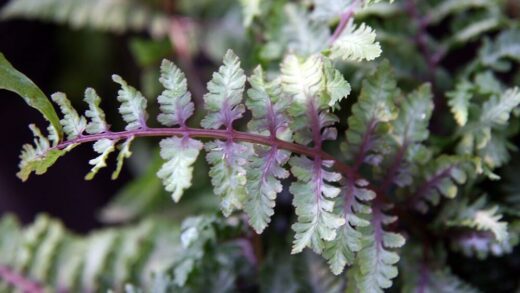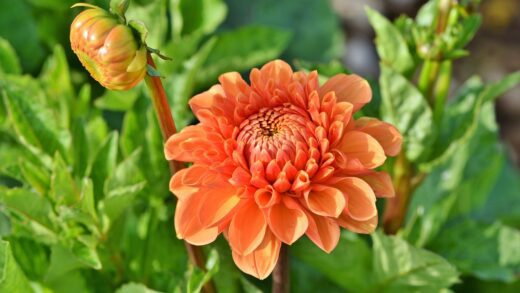The successful integration of purpletop vervain into a garden landscape begins with a strategic approach to its planting and a clear understanding of its propagation methods. This remarkable plant, celebrated for its airy texture and long-lasting purple blooms, offers a dynamic vertical element that can transform a planting scheme from ordinary to extraordinary. Whether you are starting with nursery-grown plants or propagating from your own stock, the key to success lies in replicating the conditions of its native South American habitat. This means prioritizing excellent drainage, abundant sunshine, and sufficient space for it to reach its full, elegant potential. By mastering the fundamentals of planting and exploring the various propagation techniques, you can ensure a continuous and expanding presence of this pollinator-friendly favourite in your garden for years to come.
Before placing a single plant in the ground, a thorough evaluation of the intended site is paramount to its future success. The chosen location must meet the plant’s non-negotiable requirements, which will save a great deal of effort and potential disappointment later on. This initial planning phase involves more than just finding a sunny spot; it includes assessing the soil’s composition, its ability to drain water, and the surrounding airflow. Proper site selection is the most critical decision you will make in the cultivation of purpletop vervain, as it directly influences the plant’s health, vigour, and ability to withstand environmental stresses. A well-chosen location allows the plant to thrive with minimal intervention, showcasing its natural beauty to the fullest.
The process of planting itself is straightforward, but attention to detail during this stage will give your new vervain the best possible start. It is about creating a welcoming environment for the roots to establish quickly and grow deeply, which is the foundation of a resilient and drought-tolerant plant. From the size of the planting hole to the depth at which the plant is set, each step plays a role in its successful transition into the garden. Rushing this process or cutting corners can lead to a stressed plant that struggles to establish, so taking the time to plant correctly is a worthwhile investment.
Furthermore, understanding the propagation of purpletop vervain opens up a world of possibilities for expanding your collection or sharing with fellow gardeners. This plant is generous in its ability to reproduce, offering several reliable methods, including propagation from seed, stem cuttings, and division. Each technique has its own timing and set of procedures, allowing you to choose the method that best suits your needs and skill level. Whether you are aiming to create a large, cohesive drift of vervain or simply want to produce a few extra plants, mastering these propagation skills is both rewarding and economical.
Selecting the ideal planting site
The most critical factor in selecting a site for purpletop vervain is, without question, the amount of direct sunlight it will receive. This plant is a true sun-worshipper and requires a minimum of six to eight hours of full, direct sun each day to perform at its best. Insufficient light will result in weak, leggy stems that are prone to flopping over, and it will significantly reduce the number of flowers the plant produces. When scouting your garden for the perfect location, observe the path of the sun throughout the day to identify a spot that remains unshaded for the majority of daylight hours. This will ensure the plant develops a sturdy structure and delivers the spectacular floral display it is known for.
More articles on this topic
Equally as important as sunlight is the quality and drainage of the soil. Purpletop vervain has a strong aversion to waterlogged conditions, which can quickly lead to fatal root rot. The ideal soil is one that is light, loose, and allows water to percolate through it freely. To test the drainage in a potential planting spot, dig a hole about 30 centimetres deep and fill it with water; if the water has not drained away within a few hours, the drainage is likely insufficient. In such cases, you will need to amend the soil by incorporating generous amounts of organic matter like compost, along with gritty materials such as coarse sand or fine gravel to improve its porosity.
Consider the plant’s mature size and growth habit when choosing its location within a planting bed. Purpletop vervain has a see-through quality, meaning its sparse foliage and wiry stems allow you to see other plants behind it. This makes it an excellent choice for planting in the middle or even the front of a border, where it can add height and texture without creating a solid visual barrier. Ensure you provide adequate spacing, allowing at least 30 to 45 centimetres between plants. This not only gives them room to grow but also promotes good air circulation, which is essential for preventing fungal diseases like powdery mildew.
Finally, think about the plant’s role in the wider garden ecosystem when selecting its home. Its nectar-rich flowers are incredibly attractive to a wide range of pollinators, including butterflies, bees, and hoverflies. Placing it in a location where you can easily observe this activity can bring an extra layer of enjoyment to your garden. Furthermore, positioning it near vegetable gardens or fruit trees can help to draw these beneficial insects to the areas where their pollination services are most needed. Choosing a site with these ecological considerations in mind enhances both the aesthetic and functional value of the plant.
The process of planting young verbena
The best time to plant young, nursery-grown purpletop vervain is in the spring, after all danger of frost has passed and the soil has had a chance to warm up. This timing allows the plant the entire growing season to establish a strong and extensive root system before the onset of its first winter. Planting in the heat of mid-summer can be stressful for the plant, requiring more diligent watering to help it settle in. While autumn planting is possible in milder climates, spring remains the optimal choice for ensuring the plant is robust enough to survive the cold season ahead.
More articles on this topic
When you are ready to plant, begin by digging a hole that is approximately twice as wide as the plant’s current root ball but no deeper. The width of the hole is important as it loosens the surrounding soil, making it easier for the new roots to penetrate and expand. It is a common mistake to dig the hole too deep, which can cause the plant to settle over time, sinking below the soil level and potentially leading to crown rot. The goal is to ensure that the top of the root ball sits perfectly level with the surrounding garden soil once it is placed in the hole.
Carefully remove the young verbena from its nursery pot, taking care not to damage the roots. If the plant is root-bound, with roots circling tightly around the bottom of the pot, gently tease them apart with your fingers. This encourages the roots to grow outwards into the new soil rather than continuing to grow in a constricted circular pattern. Place the plant in the centre of the prepared hole and begin backfilling with the excavated soil. If you are amending the soil with compost or other materials, mix them thoroughly with the native soil before backfilling.
Once the hole is filled, gently firm the soil around the base of the plant with your hands to eliminate any large air pockets. Immediately after planting, water the vervain thoroughly and deeply, which helps to settle the soil around the roots and provides essential moisture for its establishment. This initial watering is the most important one it will receive. For the next few weeks, monitor the soil moisture regularly and water as needed to keep the soil consistently moist but not saturated, giving your purpletop vervain the best possible start in its new home.
Propagation from seed: a detailed guide
Propagating purpletop vervain from seed is a highly effective and economical way to produce a large number of plants, perfect for creating impactful drifts in the garden. The seeds of this species have a specific requirement for a period of cold, moist conditions before they will germinate, a process known as cold stratification. You can achieve this by sowing the seeds directly in the garden in late autumn or early winter, allowing nature to provide the necessary cold period. Alternatively, for a more controlled approach, you can sow the seeds in pots or trays and mimic these conditions artificially.
For artificial stratification, sow the seeds in a tray filled with a moist, sterile seed-starting mix in late winter, typically six to eight weeks before your last expected frost date. Lightly cover the seeds with a thin layer of mix, as they require some light to germinate. Enclose the entire tray in a plastic bag to retain moisture and place it in a refrigerator for a period of two to four weeks. This cold treatment breaks the seed’s dormancy and signals that it is time to sprout. After the stratification period, the journey to germination can begin in earnest.
After removing the tray from the refrigerator, place it in a warm location with plenty of bright, indirect light. A temperature of around 21 to 24 degrees Celsius is ideal for germination. Keep the growing medium consistently moist but not waterlogged, using a fine spray bottle to avoid dislodging the seeds. Germination can be somewhat erratic, but you should start to see the first seedlings emerge within two to four weeks. Once the seedlings appear, remove the plastic cover to increase air circulation and prevent fungal issues.
When the seedlings have developed at least two sets of true leaves, they are ready to be carefully transplanted into individual small pots. This process, known as ‘pricking out,’ allows each seedling to have its own space to develop a strong root system without competition. Continue to grow them in a bright, protected location, and once the danger of frost has passed, begin to harden them off. This involves gradually exposing the young plants to outdoor conditions over a week or two before finally planting them in their permanent positions in the garden.
Vegetative propagation through cuttings
Taking stem cuttings is another excellent method for propagating purpletop vervain, with the significant advantage of producing plants that are genetically identical to the parent. This technique is particularly useful if you have a specific plant with desirable characteristics that you wish to replicate. The best time to take cuttings is from late spring to mid-summer, when the plant is in a state of active growth. Look for healthy, non-flowering stems, as these will root more readily than stems that are already producing buds or flowers.
Using a clean, sharp knife or secateurs, take cuttings that are approximately 10 to 15 centimetres long from the tips of the stems. Make the cut just below a leaf node, which is the point on the stem where a leaf emerges. Carefully strip the leaves from the lower half of the cutting, leaving only two or three pairs of leaves at the top. This reduces the amount of moisture the cutting loses through transpiration and encourages it to focus its energy on developing new roots rather than supporting excess foliage.
While not strictly necessary, dipping the cut end of the stem into a rooting hormone powder can increase the success rate and speed up the rooting process. Prepare a small pot filled with a well-draining rooting medium, such as a mix of perlite and compost or coarse sand. Use a pencil or a small stick to make a hole in the medium, then insert the cutting into the hole, ensuring that the stripped leaf nodes are buried beneath the surface. Gently firm the medium around the cutting to hold it in place.
To create a humid environment that promotes rooting, you can cover the pot with a clear plastic bag or place it in a propagator. Position the cuttings in a warm location with bright, indirect light, and keep the rooting medium consistently moist. Roots typically begin to form within three to six weeks. You can check for rooting by giving the cutting a very gentle tug; if you feel resistance, it is a sign that roots have developed. Once the cutting is well-rooted, you can transplant it into a larger pot and gradually acclimate it to outdoor conditions before planting it in the garden.


















